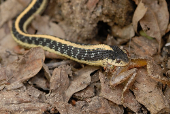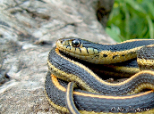Mountain Garter Snake (Thamnophis elegans elegans)
Description: measures 18 to 43 inches in length. A medium-sized slender snake with a head barely wider than the neck and keeled dorsal scales. Some scale averages: Average of 8 upper labial scales, occasionally 7, scales 6 and 7 are enlarged, higher than wide. Average of 10 lower labial scales. The front and rear pair of chin shields are equal in length. The internasals are wider than long and not pointed in front. Average scale count at mid-body is 21, rarely 19. Ground color is a dark olive-brown or black with no red markings. There are 3 well defined light stripes on the back and sides: The dorsal stripe is yellow, orange, or white. The lateral stripes may be paler. Underside is pale with few markings, and is sometimes darker in the center.
Habitat: Inhabits streamsides, springs, mountain lakes, in grassland, meadows, brush, woodland, and coniferous forest.
Range: n California, the subspecies Thamnophis elegans elegans - Mountain Gartersnake, is found throughout the Sierra Nevada Mountains, through most of the northern part of the state except for the outer Coast Ranges south at least as far as Mt. St. Helena. There is an isolated population in the San Bernardino Mountains. This subspecies ranges out of the state north into Oregon and to the edge of northern Nevada.
Found in these States:
CA |
NV
Diet: Diet includes: invertebrates such as slugs, leeches, snails, and earthworms; fish; amphibians - tadpoles, frogs, (and probably salamanders); snakes and lizards; birds; and small mammals such as mice and voles
Reproduction: Mating occurs primarily in spring. Females are ovoviviparous - they carry the eggs internally until the young are born live from July to Sepember.
Status: Listed as Least Concern in view of its wide distribution, tolerance of a broad range of habitats, presumed large population, and because it is unlikely to be declining fast enough to qualify for listing in a more threatened category.
»» Kingdom: Animalia - Animals
»» Phylum: Chordata - Chordates
»» Subphylum: Vertebrata - Vertebrates
»» Class: Reptilia - Reptiles
»» Order: Squamata - Scaled Reptiles
»» Suborder: Serpentes
»» Superfamily: Colubroidea
»» Family: Colubridae - Colubrids
»» Genus: Thamnophis
»» Species: Thamnophis elegans - Western Terrestrial Garter Snakes
»» Subspecies: Thamnophis elegans elegans - Mountain Garter Snake
This article uses material from the Wikipedia article "Western Terrestrial Garter Snake", which is released under the Creative Commons Attribution-Share-Alike License 3.0. Content may have been omitted from the original, but no content has been changed or extended.
|













